19th December 2023: Christmas Meeting - Frank Banfield Film Show
On December 19th Twenty-six branch members sat down to dine on the best of our local fryer’s specials including fish and a range of pies with deep fried chicken at its best. All went well with the food judged to be the best yet with peas served in style along with upmarket Tartare sauce. We are grateful for the branch organisers and especially our lovely ladies Sheila and Carol ably assisted in the kitchen by John and Bill.
Once again in part one we were treated to some more of Frank Banfield’s collection of vintage railway films all on 16mm with sound. Frank always comes up with a good selection. We started with an old B and W film on how the railway delivered all the goods via an extensive infrastructure of lines, yards, offices, and men (almost entirely), all organising and sorting with no mention of competing road transport here.
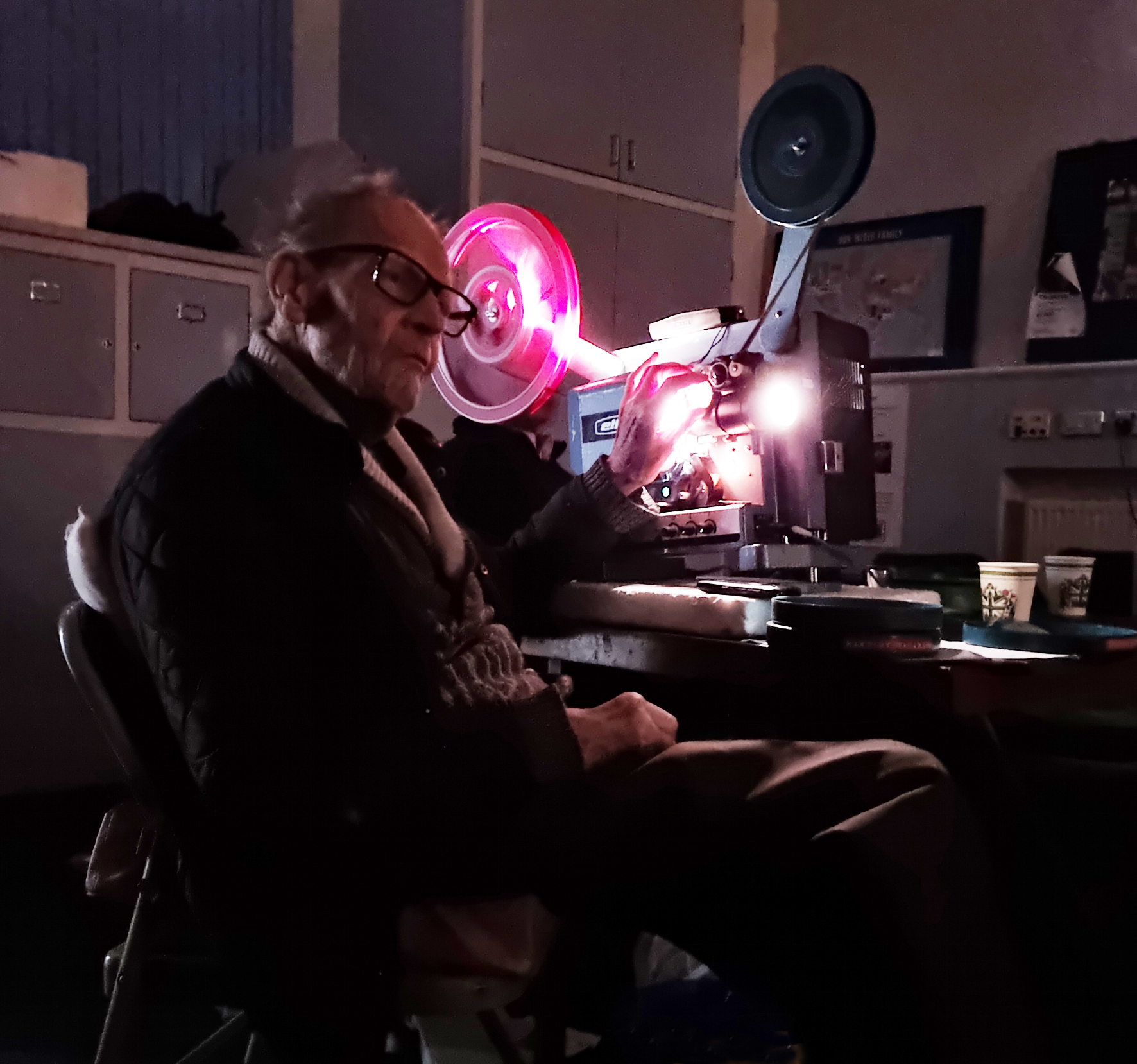

Frank Banfield projecting, and the audience enjoying, his films at the Bedford Branch Christmas Meeting
Then there was a colour visit to an open day. One of those events that used to be held in goods yard sidings where the public were invited to swarm over everything and get a great experience of how all the traction worked. In this case diesel and some steam from the 1960’s and all in colour and featuring a few iconic for those days Diesel hydraulics. Reminding us as always of those pre H&S days of fun. Laying new track featured new 1950’s technology of control and new technology to replace track and then check the resultant engineering with new track recording cars with sensitive for its time great engineering improvements linked even to new computer technology. We also enjoyed the sight of rails being welded into long Welded Rail using “The Thermit Process” with plenty of flame, sparks and smoke and what fun, something us Chemistry teachers used to try and replicate in the lab!
As we waited salivating for our food to arrive, Frank gave us a trip round Stewartby Brickworks with its wonderful brick pits, drag lines and unique transport system all feeding raw clay into furnaces full of dust and smoke with the produce finally loaded onto numerous brick trains for sending all round the UK. Many of us were pleased to recollect old locations from the amusing film. Is anyone making anything similar film wise today? All those chimneys which some of us remember and even further back London Brick Company were also big growers of potatoes but even I don’t remember that.
As we chomped through our grub and beer we enjoyed a long day out on The Ravenglass and Eskdale railway. With the presenter taking an extensive look at the line in all its glory with some history thrown in. He also enjoyed a ride on the line squeezed next to the driver with no room for shovel swivelling. The final film medley was a mixture of wartime European steam on what must be some very unusual stuff but then Frank always comes up with the goods. All that film has to be rewound and put back in its canisters for another year and he is already booked for 2024 so cheers and seasonal Wassails (CHJ 26/12/23)
5th December 2023: From The Tyne to The Tweed by Dennis Lovett.
Dennis has a distinguished role in many of the excellent series of Middleton Press books gradually covering the UK like an imagined rebirth of lines from a pre Beeching and modernisation era. Tonight, we were taken on a journey from Newcastle on Tyne to Berwick on Tweed. Our journey entailed trips along the branches to Amble, Seahouses and the short Tweed Dock line. We then took the inland route from Alnmouth to Berwick via Alnwick Wooler and Coldstream. My Ian Allan shows a territory dominated completely by The NE with a bit of NB in one corner a competition situation that might not be permitted today. This was shown in the house style of the station sites and infrastructure shown. We began classically at Newcastle opened in 1850 with coverage of the fine Central station. 15 platforms eventually with that wonderful multi junction to the south shown in all its past glory. We travelled along the main line route past Heaton Loco to Killingworth shown in its prime accommodating much race traffic. Then into coal country where most of the large stations were closed in 1958. Clean embankments, attractive stations and splendid signal boxes all attracted our eyes.
It might be forgotten today what a role the railways had in coal districts and the substantial NE infrastructure reflected that. Ashington was the main pit yard visited. Unusual were places like Amble Junction box on stilts over the line plus an amazing goods shed at Widdrington. Today the surviving stations are served by about one train a day down in the morning and back up after work.
Broomhill colliery on the Amble branch featured even an Ex N and B (Neath and Brecon to the uninitiated) and ex GWR Avonside tank still in the 1960’s earning its keep despite being built in 1872, Continuing up the east coast mainline with shots of Streaks and Deltics we ambled down the long closed Seahouses branch where I once tried to uncover some of the remains. It closed entirely in 1951 so I never found much. Did you know that Holy Island had 3 horse tramroads? Well neither did I! so thanks to Dennis we now know better but Middleton always mange to unearth the odd and unusual. At Tweedmouth a look at the docks branch and to Alnwick for a look round the station. Our travels then took us inland for a delightful country tour of a long branch via Coldstream to eventually Alnwick. The whole area was very rural and it seems amazing that this route born out of competition survived as long as it did but parts to the south closed as early as 1953 and flooding damage did for other parts. Stations were distinctive many of which survive in some form today. Many still with their distinctive bay windows where the SM’s gaze would be constant.

One location featured was Stannington, near Morpeth and the junction between the North Eastern and North British Railways, seen here in 1900.
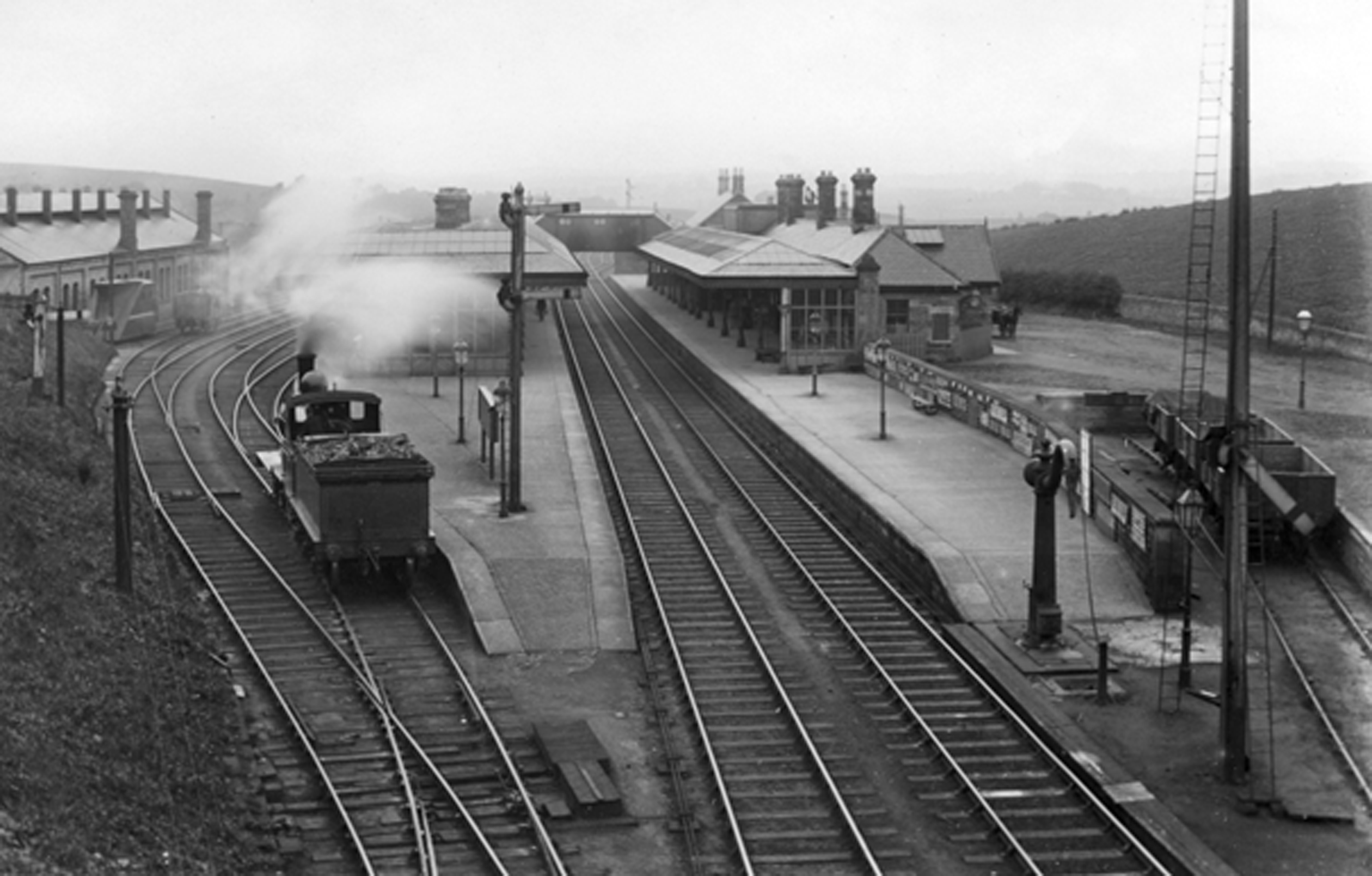
Another was Alnmouth, also pictured in 1900. Both images from post cards, courtesy Dennis Lovatt
If your appetite has been whetted as mine is, I recommend obtaining a copy of “Alnmouth to Alnwick, Coldstream and Berwick” by Roger Darsley and Dennis Lovett published of course by Middleton. The embryonic Alnmouth preservation line known as “The Aln Valley Railway” was our final stop and how they have come on, in great strides now running over the fine Cawledge viaduct on their way to an eventual stop next to the East Coast mainline at Alnmouth Station. Thanks Dennis for a fine exploring evening and doing a thorough job on this fascinating district. (CHJ 26/12/23)
7th November 2023: Railways of Northamptonshire, Part 6 - Robin Cullip
This was Robin's 6th visit to the branch, to cover the last few branch and main line sections. Part 7 is likely to cover the industrials, if so far is anything to go by it will be a great evening.
Peterborough to Thorney was our first outing towards the flat fens so very much brick flavoured and via the so-called Rhubarb bridge with its soil lining packed with that tasty vegetable. No doubt out of bounds today. We moved west into the rising ground with a look at the Wansford to Stamford branch a very early closure in 1930 with a surviving relic in Water Street Station now an old folks home and news that Wansford Rd is going to Rail World nearby. Then Glendon to Manton via Harringworth where we were shown the 1860 Glendon North box just before closure. Via Geddington, Weldon and Corby to the heavy industry of Northamptonshire now all a memory. Train loads of scrap and even a diverted Waverley passing through. Robin recounted his time in a local signal box something we all enjoy hearing about in those far off days of tea, chat and bells. Gretton station had its last train picture and nearby we were treated to many superb and striking lineside shots featured before by local PW man Mr Harris so good that this collection from the 1950’s has been preserved by Robin. Before the break we enjoyed inside shots of Manton Junction box.
The GCR came up next and a special memory for your scribe who travelled on a dark night behind a rusty black 5 from Marylebone to Rugby Central in the winter of 1965. At Leicester Central a WR engine a County no less was hauling a Sheffield Swindon parcels, A friend when a local trainspotter told me how they looked in at the GCR shed at Leicester to see what GW engines were lurking there having arrived from Banbury. South via another Harris shot of a splendid V2 in full cry. Even a wartime US 2-8-0 on freight. I loved Staverton Rd box on its stilty magnificence sitting on an embankment. The GCR had such notable large boxes. 34006 passed us on an exchange trip. Via a neat and tidy Charwelton clean of bushes and trees to the magnificence of Woodford. The shed was shown complimented by maps of the yards. Local engine ‘Chicheley Hall’ was seen on a Bournemouth to York. Shots followed as we travelled towards London via Culworth and Helmdon with a good Leonard Mill shot of the last train. Colin Walker (inveterate photographer of the Welsh Borders) had captured a shot of a train crossing the splendid but now mourned Brackley viaduct. Eydon Rd cabin another splendid Box with an L1 nearby. We finished with ‘County Of Northampton’ on the GCR as a tribute to Ian Lyman and the Northampton Regiment.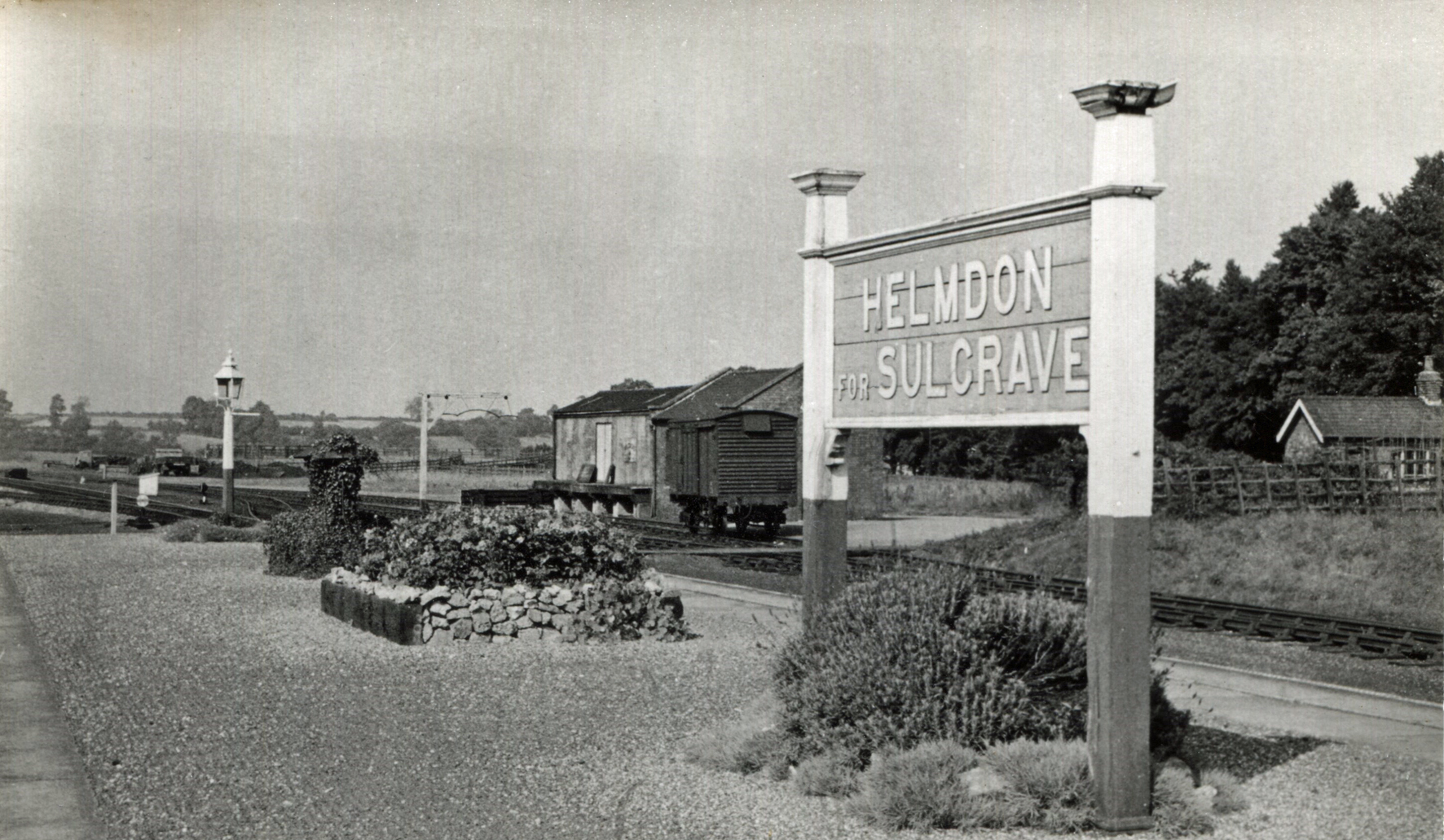
Helmdon Station Nameboard
Researching and searching for information on old lines is but ultimately rewarding so thank you, Robin, as these lines deserve not to be forgotten. (CHJ)
17th October 2023: Annual General Meeting, followed by North Eastern Railway and Region - Ray Schofield
After the Branch AGM business had been swiftly expedited with the current committee being returned for a further year, Branch member Ray Schofield showed a few images demonstrating why h had been so busy in the previous 10 days prior, commencing with a picture of 7029 passing Sandy, taken enroute to a match at Portman Road Ipswich, with a pair of Brigands from Brickhill Bedford leaping over the yellow line at the last moment!
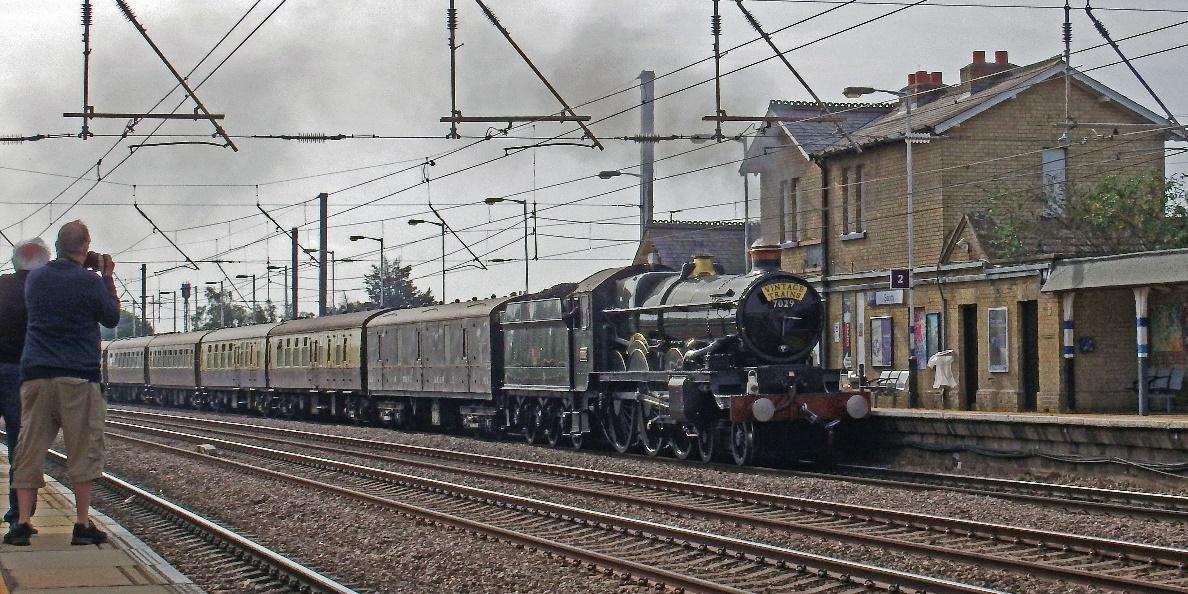
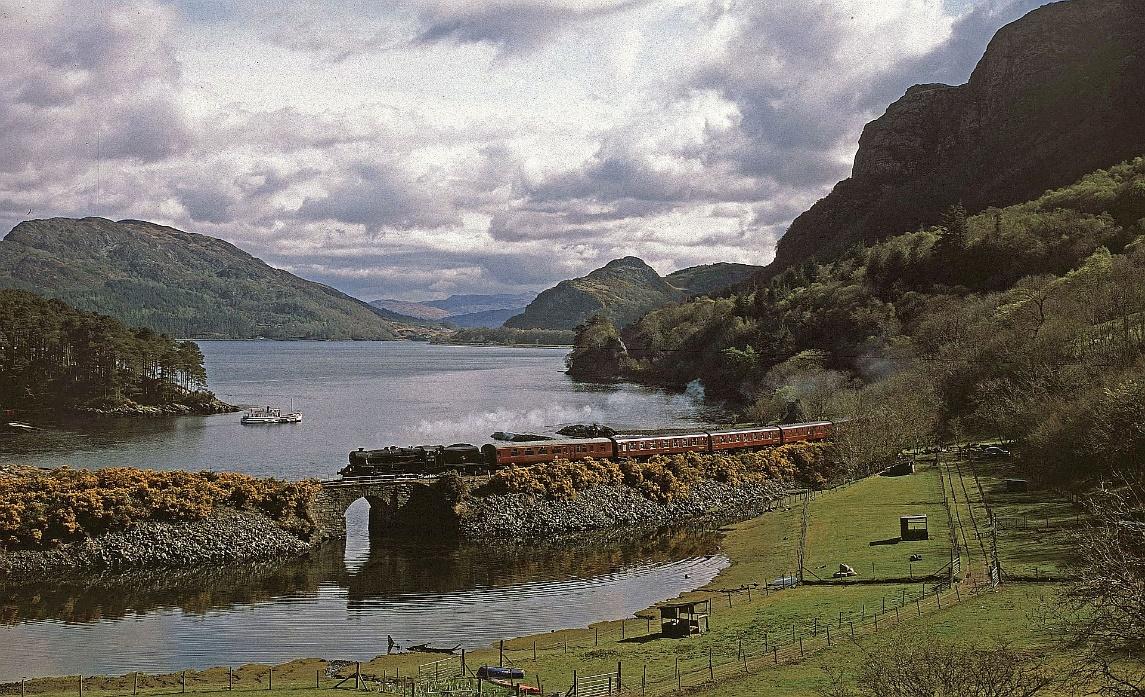
T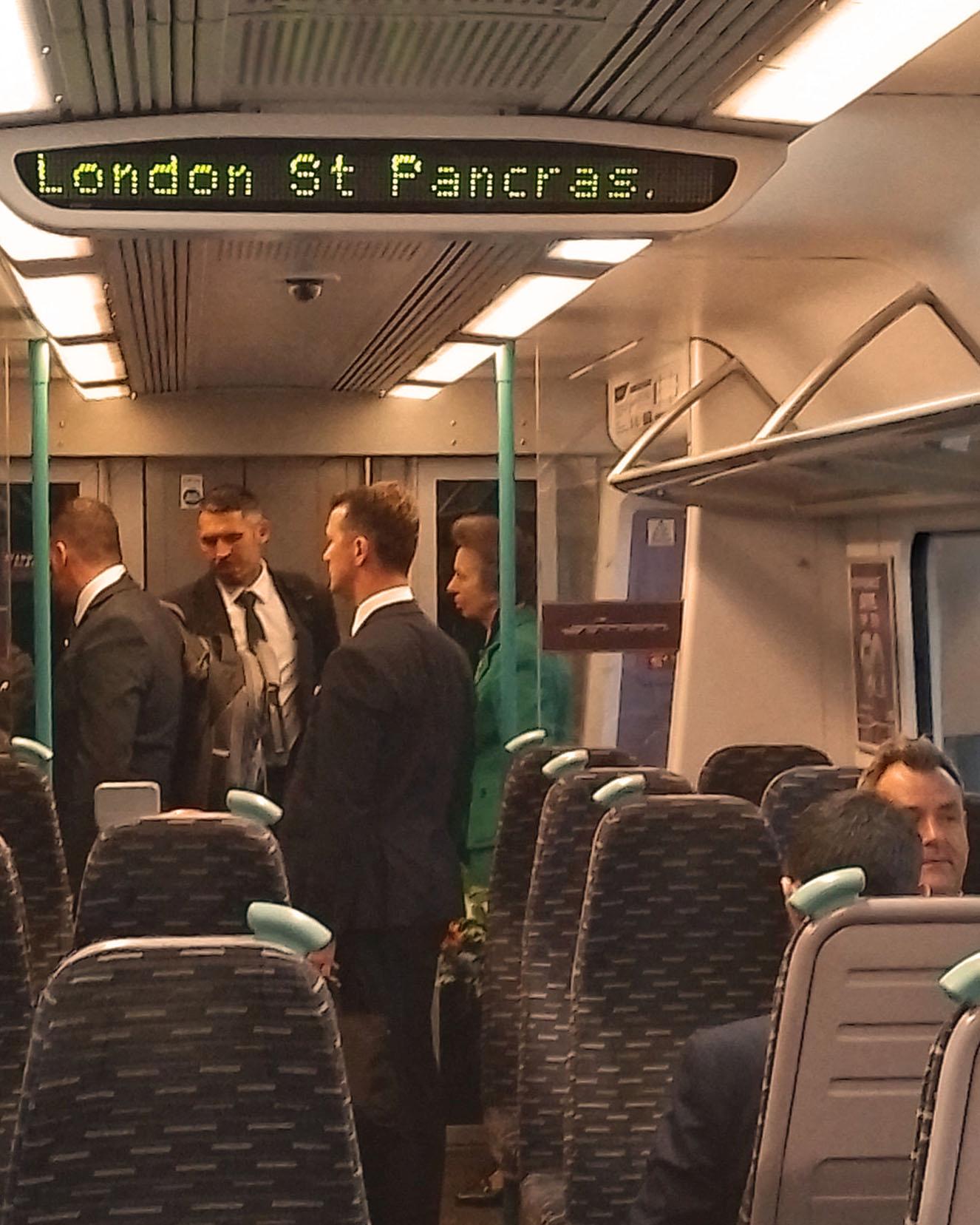 hen he'd been all the way to Basingstoke for one of his 3 Scottish talks, and the following day to the Continental Railway Circle meeting, when he found himself travelling on the Royal Train after the Princess Royal boarded his coach.
hen he'd been all the way to Basingstoke for one of his 3 Scottish talks, and the following day to the Continental Railway Circle meeting, when he found himself travelling on the Royal Train after the Princess Royal boarded his coach.
These were just a prelude to his talk on the North Eastern Railway and Region, explaining that, as the S&D Bi-centenary will be there in 2025, he's spent some time on researching the origins of rails in the region and the formation of the ECML through it from its start to more recent times. All the various ECML alternative routes were shown from the first rail service to Scotland in 1847 (commencing at Euston!) through to the Selby Diversion in 1983, the last of 4 routes through York and on to Berwick, including also the 4 routes from Ferryhill to Newcastle Central. (Chris Jones, branch secretary)
5th September 2023: Steam around Leeds and Bradford, and the Northeast, 1967-1971 - Michael Smyth
In September, Bedford Branch welcomed Michael back for part two of his B and W coverage of the end of steam in Leeds and the Northwest. The photos are stunning and convey their subject so well that we wouldn't have minded if it was part 25. These photos have also survived the years in good shape and are a tribute to the then young Michael composing his shots well. The tour began at the heart of the Northwest where enthusiasts chased the last of steam and featured first was Manchester Exchange and Mills Platting among other areas. Grubby Black 5's with bankers attached moved before our eyes. The gloomy nature of run-down facilities was all too obvious. Steam’s last bark in scenes Colin Gifford would have been proud of. After all the grime we were then treated to a country outing along the still extant Grassington Branch . More great shots of this what was practically last steam worked branch in an unexpected industrial bit of the north. Good to hear that it still moves considerable loads of stone by rail. A return to Manchester saw us up to the break and a chance to mull over what we had seen. After the break Michael returned back to Rose Grove, Hest Bank and Copy Pit. Despite the late date of July 68 some steam was still getting through often towards and just about to Leeds. We were treated to the last banker runs at Copy pit with some nostalgic shots of steam's final hour. 48151 as the last of these long-lost bankers will live on in our memories and how it along with others survived to cutters torch as we saw in a visit Michael made to Di Woodhams famous yard at Barry as he began to run out of steam subjects.
Fearing for his sanity after the end of steam. Michael set off to photograph the famous last August specials which we saw in all their glory. The pictures also showed that bygone and freer age of access. Then some industrials and to France and a magnificent pacific which Michael was stunned to see. I also remember the wonderment of seeing a French pacific for the first time waiting to speed us away on a warm dawn key side at Dunkirk as our ferry tied up in 1958. I think the final shot or two of dereliction, empty steam sheds and a last look at a wrecked Holbeck, made us perhaps think that dirty steam had had its day, and a new railway was about to emerge. However, wallowing in nostalgia is good for us all.
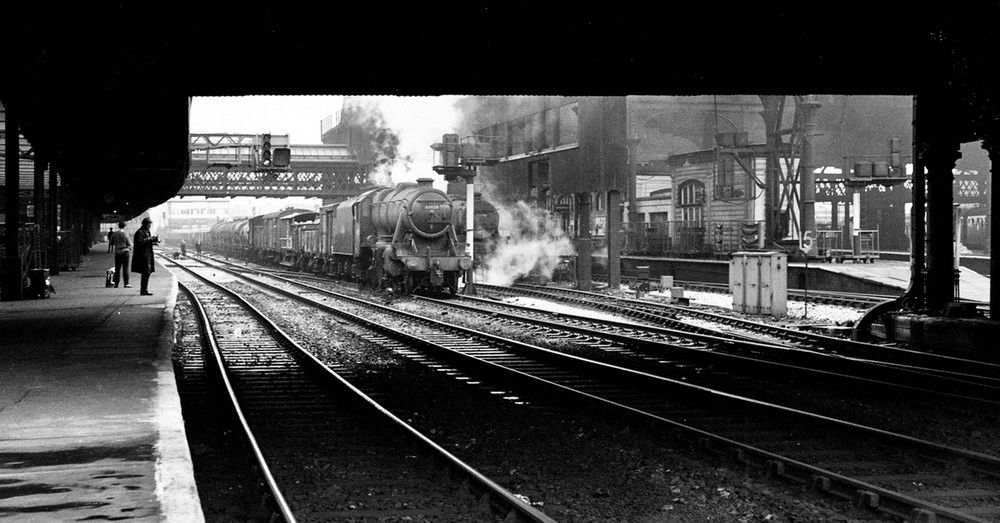 Manchester Victoria, in the last week of steam at Manchester, 25 June 1968. Image: Michael Smyth
Manchester Victoria, in the last week of steam at Manchester, 25 June 1968. Image: Michael Smyth
 Fires dropped for the final time at Rose Grove shed, Saturday 3 August 1968. Image: Michael Smyth
Fires dropped for the final time at Rose Grove shed, Saturday 3 August 1968. Image: Michael Smyth
4 July 2023: The Last Years of Steam Across Somerset & Dorset - Michael Clemens
Because the advertised speaker could not attend, Michael Clemens stood in at very short notice with his presentation that was previously cancelled during the Covid shut down.
The meeting was billed as ‘The Last Years of Steam Across Somerset & Dorset’ and it certainly was by photographs and film. Michael is to be well congratulated for not only his superb talk and photos but all he does via his web site to make photographs, books, films and tickets available to us all to enjoy from the amazing collection amassed by himself and his late father Jim Clemens.
The focus of his digital photographic tour was The S and D and the area it encompassed from the early 1960's.
We started at Bristol Temple Meads with a look at the sad sight of withdrawn locos. But cheer up here we are at Bath Green Park and sheds in all its lingering steam glory and off down the route south passing colliery scenes now seeming so remote. Down to Shepton Mallet and wells with its variety of stations all well covered and explained. Then off to the seaside at Burnham still then receiving excursion traffic and how grateful we were for presumably a family holiday in the area as we spotted the caravan. Highbridge and all its flat crossing complications were explored. Everything in those far off days was so easy to explore and photograph with not a tree, bush or fence in sight. Then to view the complex at Evercreech Junction
Bridgewater and its port complex enlightened us especially seeing ex CR 1338 which went to Swansea next before preservation in action, but Bridgewater North had gone by then. We again were so fortunate that JC went there and was able in those days to get into the port to take photographs and record the history.
We headed further west for a run along the Barnstable branch from Taunton before a brief sojourn at the Junction. Over now to Chard and the wonderful Brunel train shed. We visited Yeovil complete with prize cattle wagon and some tickets from the extensive collection which had cropped up throughout our tour.
After the break we journeyed south to Bournemouth and Corfe to include clay lines and branches.
The film, taken by his father Jim, then came out with S and D mostly cantered around Burnham, Highbridge and Templecombe and even the little southbound S and D platform under the main line and its one stopper which I once ventured down to see.
Michael, again thanks for standing in at short notice and for such a brilliant tour that was only a small part of your collection. (Chris Jones, Branch Secretary)
The Michael & Jim Clemens collections can be found on the web, at https://www.michaelclemensrailways.co.uk/.
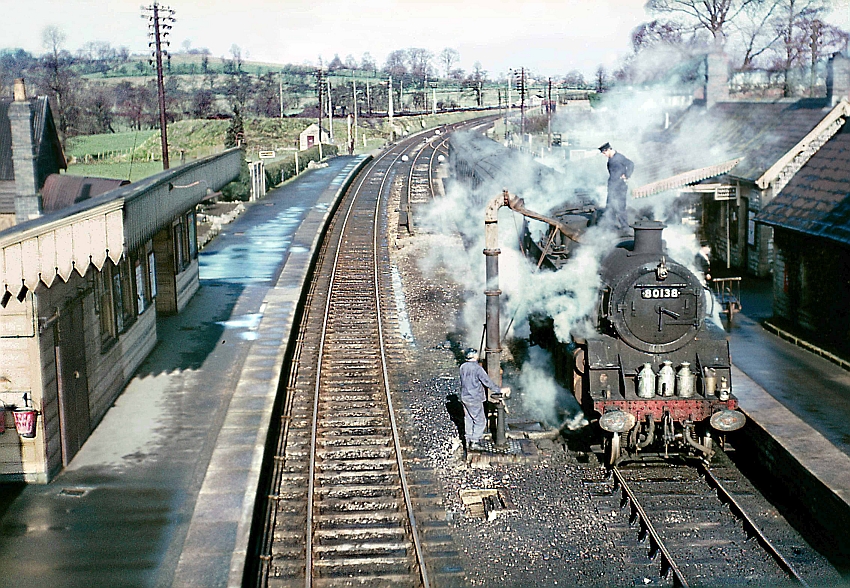 On 3rd March 1966, the last Thursday that Evercreech Junction was open for business. Bournemouth (70F) allocated Standard 2-6-4T 80138 is filling its tanks after arrival from Bath Green Park and was due to depart for Templecombe at 9.32 a.m. Noticeable are the metal containers on the locomotive buffer; according to Eric Parker’s diary, these are full of drinking water for the Bruton Road level crossing keeper, the train making a special stop to drop them off by the cottage but not for much longer. (Image from the Michael Clemens collection)
On 3rd March 1966, the last Thursday that Evercreech Junction was open for business. Bournemouth (70F) allocated Standard 2-6-4T 80138 is filling its tanks after arrival from Bath Green Park and was due to depart for Templecombe at 9.32 a.m. Noticeable are the metal containers on the locomotive buffer; according to Eric Parker’s diary, these are full of drinking water for the Bruton Road level crossing keeper, the train making a special stop to drop them off by the cottage but not for much longer. (Image from the Michael Clemens collection)
6 June 2023: The North Staffordshire Railway, Part 4 - Brian Sullivan
At our June Meeting we welcomed back Brian Sullivan to present the North Staffordshire Railway Part 4, the latest in a series of talks instigated by the late Tommy Tomalin, continued by our speaker who was using our new speaker system purchased in memory of Geoff Biggs, our Late and much missed former Secretary.
We started at Stoke on Trent Sheds and Works. The latter was a short lived affair which became a victim of Aspinall’s rationalisation of LMS workshops closing in 1927 allowing redundant men to transfer to Crewe travelling on specially provided staff trains which lasted well into BR days. The site was then leased to an engineering company Robert Hyde which carried on the lease into British Railways.
The Loco Shed was in two parts split by the main lines South of Stoke. A Roundhouse built in 1849 followed by a straight shed on the eastern side of the main lines both still in use almost until the end of steam.
We then moved onto the Potteries Loop Line which left the main route to Manchester and Crewe at Etruria Junction winding its way round the heavily Industrialised Potteries before re-joining the main line at Kidsgrove, this line coming into its own, whilst Electrification took place in the early 1960’s for diverted trains.
Next came the Kidsgrove to Macclesfield main line NS metals extended through to Marple Wharf jointly with the Great Central seemingly worked by the latter throughout its existence.
Much of the latter routes despite closure have been retained as Linear Parks affording Walkers and cyclists an easy route to enjoy what remains today.
Our gratitude to Brian for his lavishly illustrated unravelling of this complex of lines so that we could all enjoy a very nostalgic recall of a compact system of a mere 221 miles of The North Staffordshire Railway. (Bill Davies, Bedford Branch Chairman)
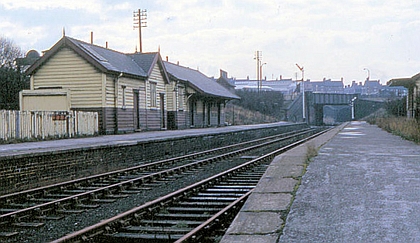
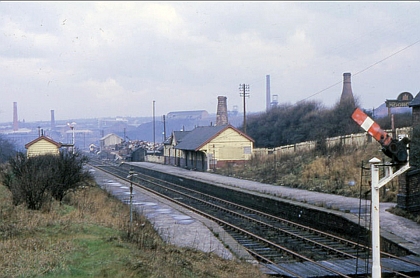 Images of Cobridge station (closed 2nd March 1964) by Tommy Tomalin. On the left, in the late 1950s, looking south towards Hanley and Etruria Junction, with Cobridge tunnel visible beyond the overbridge. Right: looking north on 2-1-1966. The gardens are now an overgrown wilderness, buildings are boarded up and some demolition has taken place
Images of Cobridge station (closed 2nd March 1964) by Tommy Tomalin. On the left, in the late 1950s, looking south towards Hanley and Etruria Junction, with Cobridge tunnel visible beyond the overbridge. Right: looking north on 2-1-1966. The gardens are now an overgrown wilderness, buildings are boarded up and some demolition has taken place
2 May 2023: The Corris Railway Yesterday & Today - Chris Jones
The Corris Railway is one of several narrow-gauge lines of varying lengths dotting along the North Wales coast, but as we will hear, The Corris and the neighbouring Talyllyn luckily shared the same 2ft 3"gauge. Branch secretary Chris Jones, our speaker on 5/5 first visited The Corris in Summer 1966 when he photographed the old station. His interest developed when, with his friend David, he made many visits including meeting the Corris historian W.H.A. Edwards. David died from Parkinson’s complications last year and fortunately Chris has been able to save David's photos and memorabilia, mostly received from David’s Uncle Will.
The Corris began as a horse-working line running for about 8 miles from slate quarries at Ratgoed to a Dovey River wharf at Derwenlas. Chris wove the story of the line with snippets from History and many amusing anecdotes gleaned from numerous visits and reading many books on the line. The Corris Supporters group helped to supply photos as did Alan Keef, manufacturer of new loco No 10, about to arrive in August 2023. It is a replica of Hughes Tramway Co’s No 3 now residing on The Talyllyn railway.
The line started out in 1859 as a purely horse worked system. The line even had its own ship, "The Aberllefenni Quarry Maid", but sadly no image of her exists. The lower two miles to Derwenlas closed after only a few years with the arrival of the standard gauge in Machynlleth in 1863. From then on slate traffic could be exchanged there. Passengers were carried from 1883 with three new Hughes Tramway Co., engines. The passenger service was a great success and we saw some examples of the comfortable carriages, including the one survivor, now on The Talyllyn, which spent many year on a Gobowen farm.
Chris took us on a tour up the line visiting stations and landmarks and the history unfolded as the little train climbed up the valley in its Bosky Dell. Passengers mostly got out at Corris and went on coach trips, latterly motor buses to the nearby Talyllyn Lake. Under the energetic Mr Dix the line flourished. However, all that was to end when the company was sold to the GWR in 1930. The passenger service was hastily ended by the GWR in 1931. After that until closure in 1948 there was only a goods service with surviving engines No 3 and new arrival No 4, a 1921 built Kerr Stuart.
We heard how the locos were saved by the wily local station master and ended up on the Talyllyn. We enjoyed the sight of the guard pouring sand while sitting on the buffer beam of No 3. There was also a trip on the unique Ratgoed tramway which for a few years operated under the BR banner. The presentation finished with a look at all four engines, the two survivors and their replicas, No 7 and the soon to arrive No 10. Long live the resurgent Corris running for about a mile but it may yet achieve over two with much hard work from the volunteers, which they are very good at.
Thanks, Chris for an informative and enjoyable evening. Chris donated his fees to the Parkinson's Foundation.
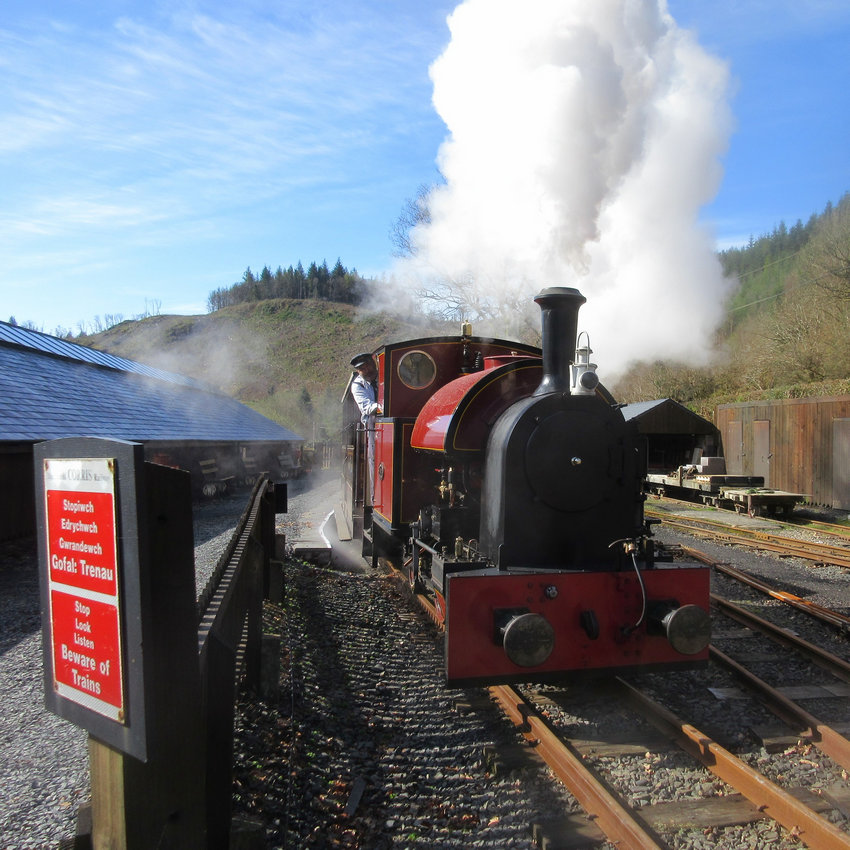
Corris Railway No 7 leaving Maespoeth Photo courtesy Corris Railway
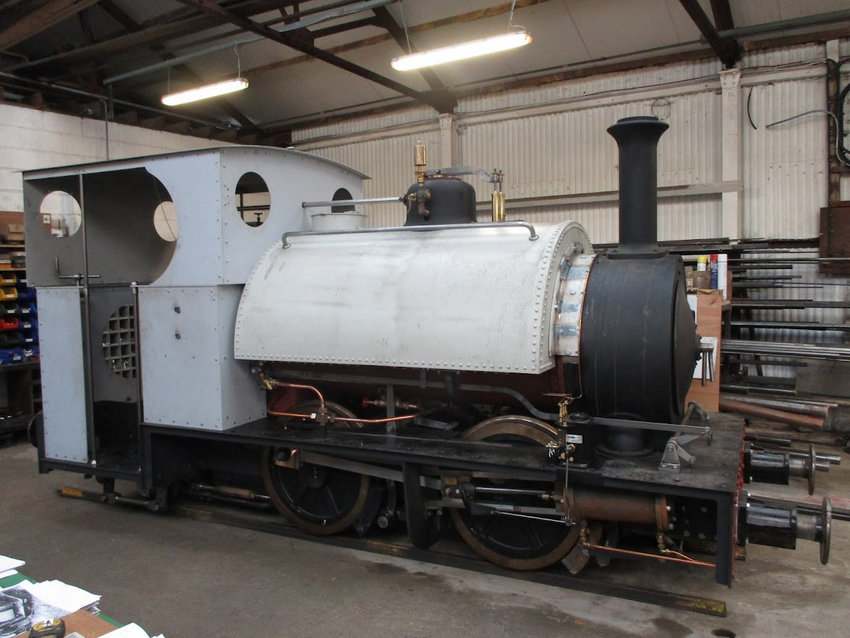
New Corris Railway No 10 under construction in Alan Keef’s workshop, June 2023. Photo: Alan Keef
4 April 2023: The Royal Scots - David Hunt
David was an airline pilot by profession and these magnificent machines certainly flew along in the hands of sympathetic crews and it seems subject to numerous modifications and improvements which David meticulously outlined; the writer would have felt very safe as no doubt the same attention to detail would have been shown to his flying steed in the air.
The story starts with the grouping in 1923 and the formation of The LMS monolith. He was quick to dispel the small engine policy of The Midland. More a problem of weak bridges and a careful locomotive use policy. The LNWR on the other hand with its black livery and overworked engines was a different animal. Note: At the time of writing David is the current Chairman of the Midland Railway Society so is well versed with MR policy. A new start was needed but the LMS went for The Midland version of things. Many ideas were tried including some based on the excellent Collett Castles with suggestions of improved Castles or a new Deeley inspired engine series. The LMS even borrowed a Castle and fed it hard Yorkshire coal which it no doubt coughed up its chimney.
The North British company was hired to build a batch of 3-cylinder engines with 250psi higher pressure boilers, seemingly the solution to produce a powerful machine for the west coast mainline to compete with the LNER on the east coast route. What emerged in 1927 wasn't a SR Nelson; it had Deeley valve gear and 250psi boiler. 49 more emerged in 1927 and another 20 were built at Derby in 1930. Subsequently many changes and improvements were made, some lasted and others were removed. Eventually the look of these machines changed, from1943 onwards emerging from Crewe with new taper boilers. We must not forget 6170, re-built at Crewe from the experimental high-pressure compound 4-6-0 No 6399 Fury with a taper boiler in 1935.
Summing up they were said eventually to be possibly the best engines on BR and even outperformed the Kings. Thank you, David for dispelling some long-standing myths and unravelling a complex story, with a precise summing up of the gestation, engineering and running of The Royal Scots. Of course, there are several very good books including David’s own collaboration with other experts that you can delve into or just look out for the preserved ones Nos 6100 & 6115 when they are down your way. (CHJ)
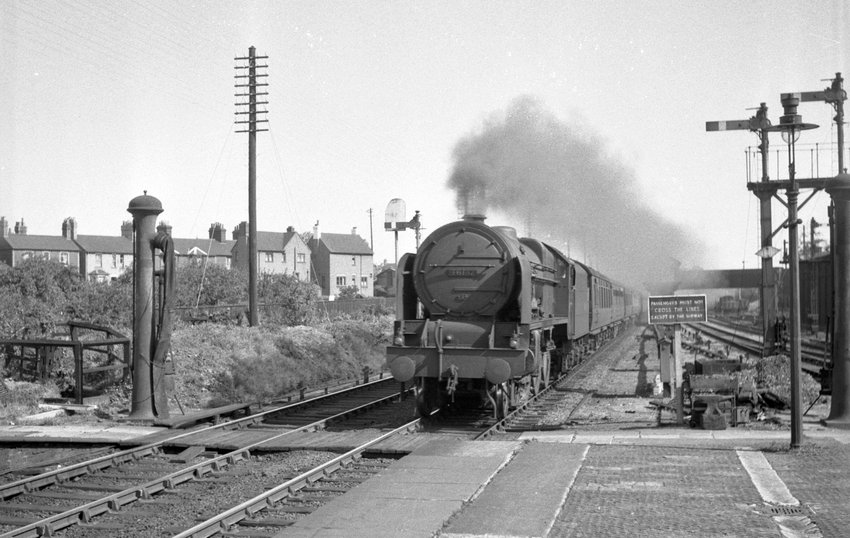
Un-rebuilt Royal Scot 46137 ‘The Prince of Wales’s Volunteers, South Lancashire’. (original name ‘Vestra’) on an up express approaching Leighton Buzzard on the 15th August 1949. It was rebuilt at Crewe with a 2A the following year, 1950. Photo: H.G.Clements.
9 March 2023: The Final 10 years of East Lincolnshire Railways - Mike Fowler
Mike Fowler's coverage of the last 10 years of the rural East Lincolnshire railways was masterful in its conception and outstanding in its delivery. Never before have I attended such an iconoclastic presentation. David used all media opportunities as befits a former BBC producer, so we were treated to outstanding use of film covering the period from 1960 with projected images and maps to contextualise this exploration. I was especially attracted to the video contributions and following tributes to ex railwaymen involved at the end.
Good that historians had bothered to record the everyday comments and lives of workers once part of our landscape. To show that Lincolnshire railways were decimated was brought home by a final map showing only Sir Billy Butlin had achieved his aim of saving (some sort) of a line to Skegness and to his holiday camp. In pictures, maps and Mike's informed commentary we in turn visited the lines under sentence and this is where the sentencers were listed in turn. Railway villainy from Messrs Castle/Beeching/Marples and Marsh. Though some praise was handed out and the great and good Dr Beeching who always seems to have his supporters.
Lincolnshire, or at least the bit under consideration, is rather flat so level crossings abounded and statistics were added to this such as an example: 78miles with 68 crossings.
In my own case working in agriculture, I found crossing keepers rather useful as they knew when farmers I was looking for had passed the crossing however this is no justification for keeping them.
Mike had also mined a rich seam of posters and marketing material all designed to attract travellers. Sadly, most passengers were confined to one or two services in what was predominantly an agricultural district. The rundown was well covered as we saw for instance the ending of the pickup goods as it ambled through the countryside. Some efforts were made by local initiatives to run special trains and even Flying Scotsman got involved. How I miss the local press decimated by Covid as they in their unassuming way documented protest followed by closure followed by the scrap man or as we know the spanner and screwdriver brigade. Much was saved and featured in Mikes photographs. If only we had done more or as he said had a bigger car.
There was very little not covered in this comprehensive survey as the dominoes went down so after the break 1960 to 1970 was a sad liturgy of changes from no fish to no allotments or to no majestic signal boxes and no wayside stations.
I am looking forward to the book as this was not yet another tribute to the steam engine but a tribute to a way of life now long ago.
I hope this talk can be used as a model for all others in its way of teaching how society and history can teach new audiences about what happened to our rural railways now some 60 years or so past.

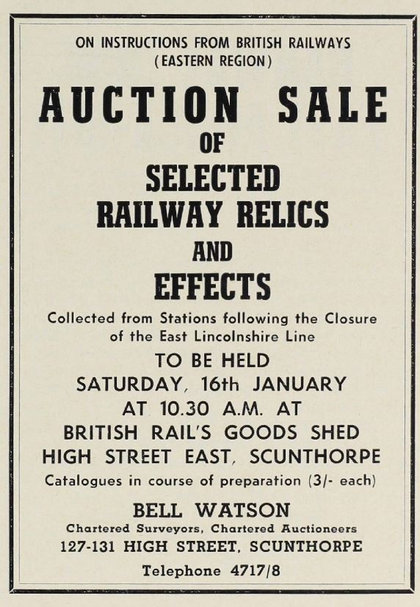
- Final closure poster declaring the cessation of services on the East Lincolnshire lines; and Poster advertising the auction of Relics & Effects following closure of the East Lincolnshire Lines: both from the Mike Fowler collection.
7 February 2023: The Cambridge Area Yesterday & Today: Part 3 - Dave Scudamore
This was a very comprehensive survey covering a relatively small area and a few railway routes but gave us an extensive evening’s entertainment.
All routes begin at Cambridge and our tour subsequently took us down to Audley End on GE metals then back via Bartlow to Cambridge again. The next run was to Hitchin where GE morphed into GN at Shepreth. Finally, back again to Cambridge before a LNWR run down to Sandy. Pre-Group companies and some narrow-gauge minor freight lines so we all enjoyed an excellent evening's tour.
Cambridge always fascinates with even the MR getting a goods toe hold here. There were views of the station both historic and contemporary with the famous long platform shown even if it now has a fence across in C21 style. The two sheds were covered in good detail. Even some loaned SR Pacific’s were seen but soon sent packing. What other great variety from N7's to V1's and V4's. Spotters notebooks needed. We enjoyed views to the south as spotters gathered and we could remember the late Geoff Webb with some of his excellent Signal Box shots featured. Sir Nigel and Tornado photographed heading south on specials added to the varied scene. Scenes to the south showed many changes under the wires but old photos revealed long lost people and shunting horses very useful in mostly flat East Anglia. On the way round to Bartlow we were treated to Dave’s good grasp of his subject with opening and closing dates with more yesterday and today photos.
Audley End featured a miniature railway as well as The Esligen railbus. At Bartlow we were grateful for Tommy Tomalin and his legacy of photos available for talks like these. Towards Hitchin gave an opportunity for a tour of the Barrington complex with Sentinels blending in to modern traction views. South of Cambridge is Coprolite territory as on parts of the Sandy branch and Geoff included much detail of the movement of this interesting product by NG rail. At Hitchin we enjoyed views of the "new" flyover. Our final trip was down the line to Sandy with this time The LNWR to the fore. As in other parts though long closed many of the stations such as Old North Rd and Potton survive in private ownership. I was especially pleased to see that a photo of Sand Heath box has survived and was shown tonight.
So thanks Dave for all your research and great photos of stations, people both staff and passengers, and a few horses. (Chris Jones)
 61659 “East Anglian” (B17/5 4-6-0) on Cambridge shed c1949. Only streamlined loco to be allocated to Cambridge. Photo: Copyright David Scudamore collection.
61659 “East Anglian” (B17/5 4-6-0) on Cambridge shed c1949. Only streamlined loco to be allocated to Cambridge. Photo: Copyright David Scudamore collection.
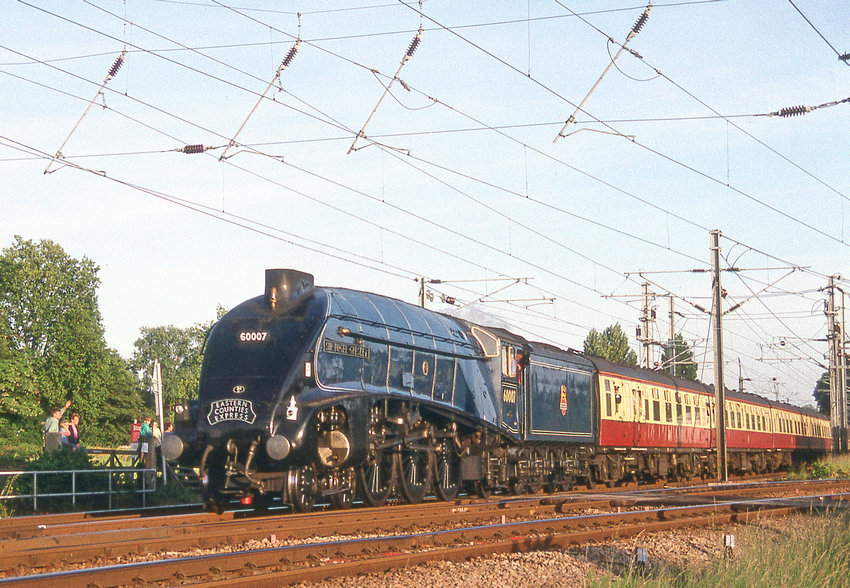 60007 “Sir Nigel Gresley” at Shepreth Branch Jn heading north towards Cambridge with “Eastern Counties Express” special from Bishops Stortford to Ely. Photo: Copyright David Scudamore.
60007 “Sir Nigel Gresley” at Shepreth Branch Jn heading north towards Cambridge with “Eastern Counties Express” special from Bishops Stortford to Ely. Photo: Copyright David Scudamore.
3 January 2023: Lancashire’s Railways Revisited - Richard Crane.
To start our new year of meetings Richard Crane gave another of his excellent presentations of a County in Railways. He has explored the area himself so was able to give a first-class account.
His chosen county was Lancashire mostly based on the Lancaster region. A visit and tour of county lines is of great value so we can add to our rich railway experience in building a picture and stimulating interest in past and present. Lancashire as a county had a vast network of railways so covering all would have been as shimmy as a stone on a pond so Richard's tour concentrated on many of the rural outposts beginning around Lancaster with visits to Green Eyre and out to the coast on the electrified route to Morecambe showing the Midland Railway as suburban electrification pioneers. This line featured some attractive Signal boxes now sadly demolished as were many other attractive structures leaving a basic railway. We saw excellent loco pictures including the last-named BR express and another "loco" character - a grand statue of Eric Morecambe.
Back to Castle Station at Lancaster on the main line and up to Carnforth where the coast was briefly glimpsed at Bolton Le Sands. We had a wander around Carnforth and our imaginations were stirred as we breathlessly followed Celia Johnson down the tunnels remembered in the film "Brief Encounter”. We went to the county boundary on the Furness branch to Silverdale. The Midland wasn't forgotten as we hit the countryside towards Settle stopping near Wennington Junction.
Richard transported us back south via The Garstang and Knott End a curious short line losing its passenger service many years ago. At Preston we looked at a fine signal gantry visited the dock site and looked in at the Ribble Heritage Railway. Then over to Blackpool via Wyre Dock and its fish traffic. At Blackpool the situation has changed considerably as we took a look round at past and present, learning that Blackpool Central had up to 14 platforms but was closed in 1964. On the branch out we looked at Lytham with its good tavern and Richard recommended a visit to the West Lancaster Light Railway at Hesketh Bank. We went on via Preston towards Bolton. To finish in the dying days of real steam at Copy Pit and Lostock Hall. At least now the steam engine has arisen from the ashes to make a triumphant return. Thanks Richard for an enjoyable tour. (Chris Jones)
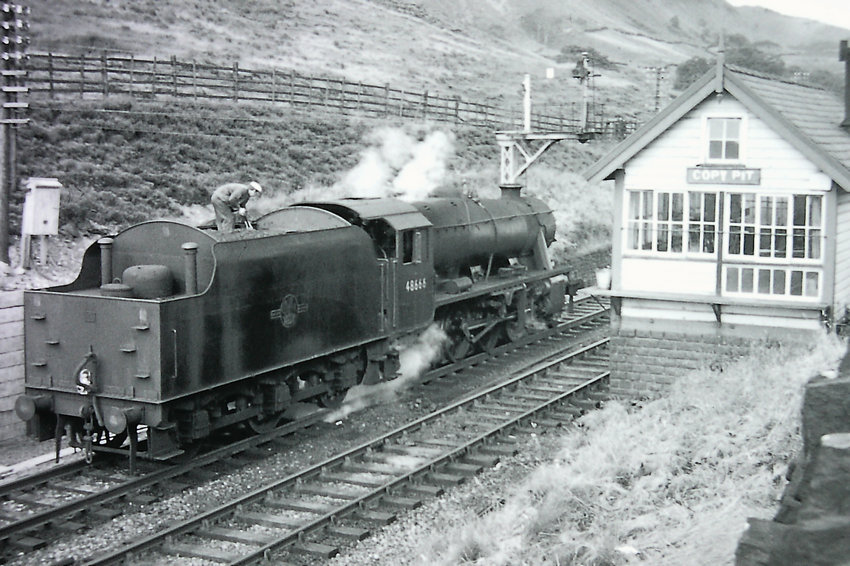
Rose Grove (10F) Stanier 8F 2-8-0 48666 stands at Copy Pit. Possibly waiting to continue with its banking duties or maybe to return to its home shed for the very last time. 2nd August 1968. (The late Ken Dickens)
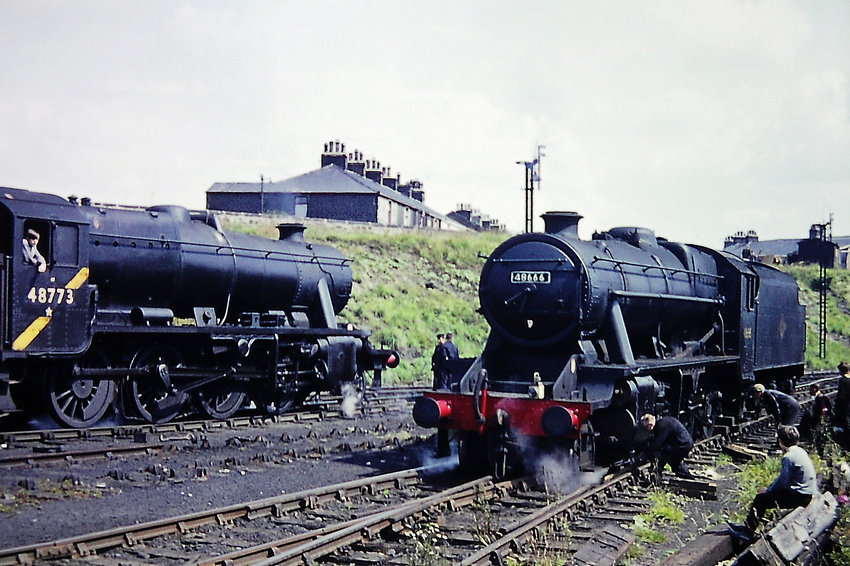
48666 now back from its last banking duties at Copy Pit embarrassingly derailed in the yard on its way onto Rose Grove. 48773 is standing by to help with the re-railing. 48666 may have the honour of being the last BR locomotive to be derailed in service. (The late Ken Dickens)
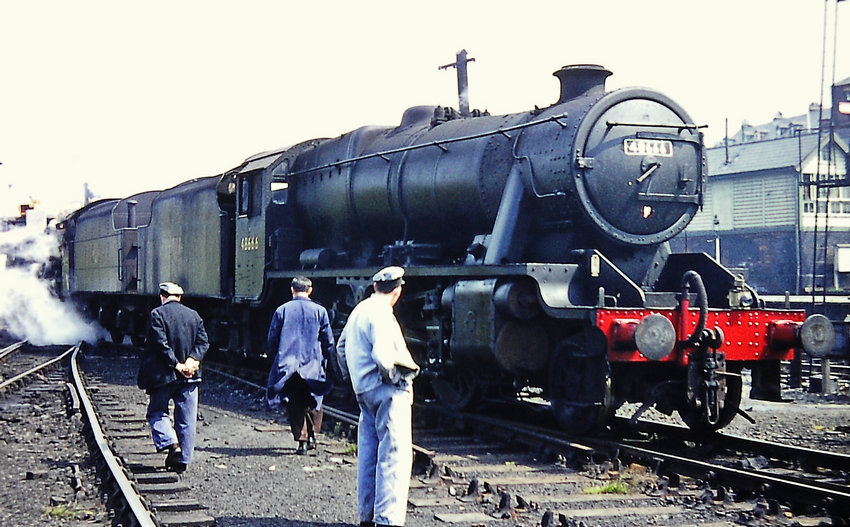
48773 dragging the disgraced 48666 back after re-railing. 48666 was then added to the shed withdrawn for scrap line. (The late Ken Dickens)
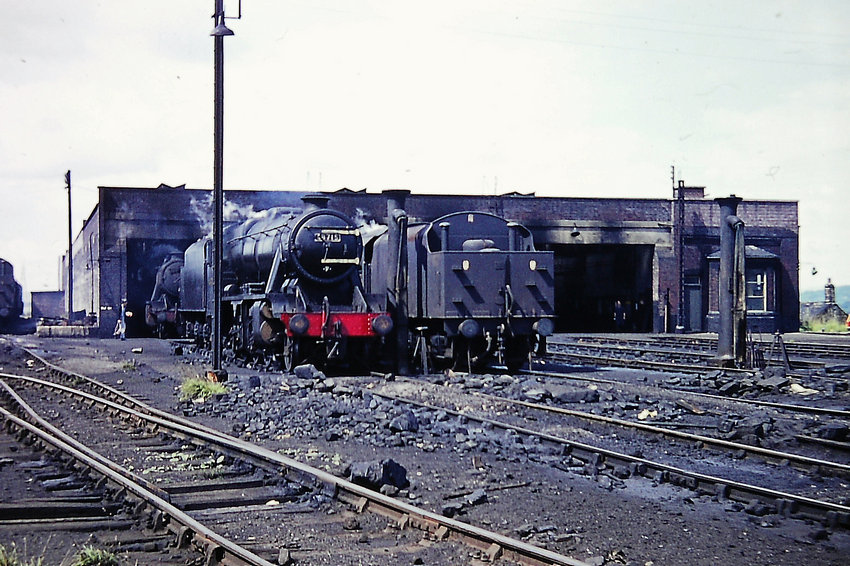
48715 and several other Rose Grove 8F’s wondering what all the fuss was about. (The late Ken Dickens)
